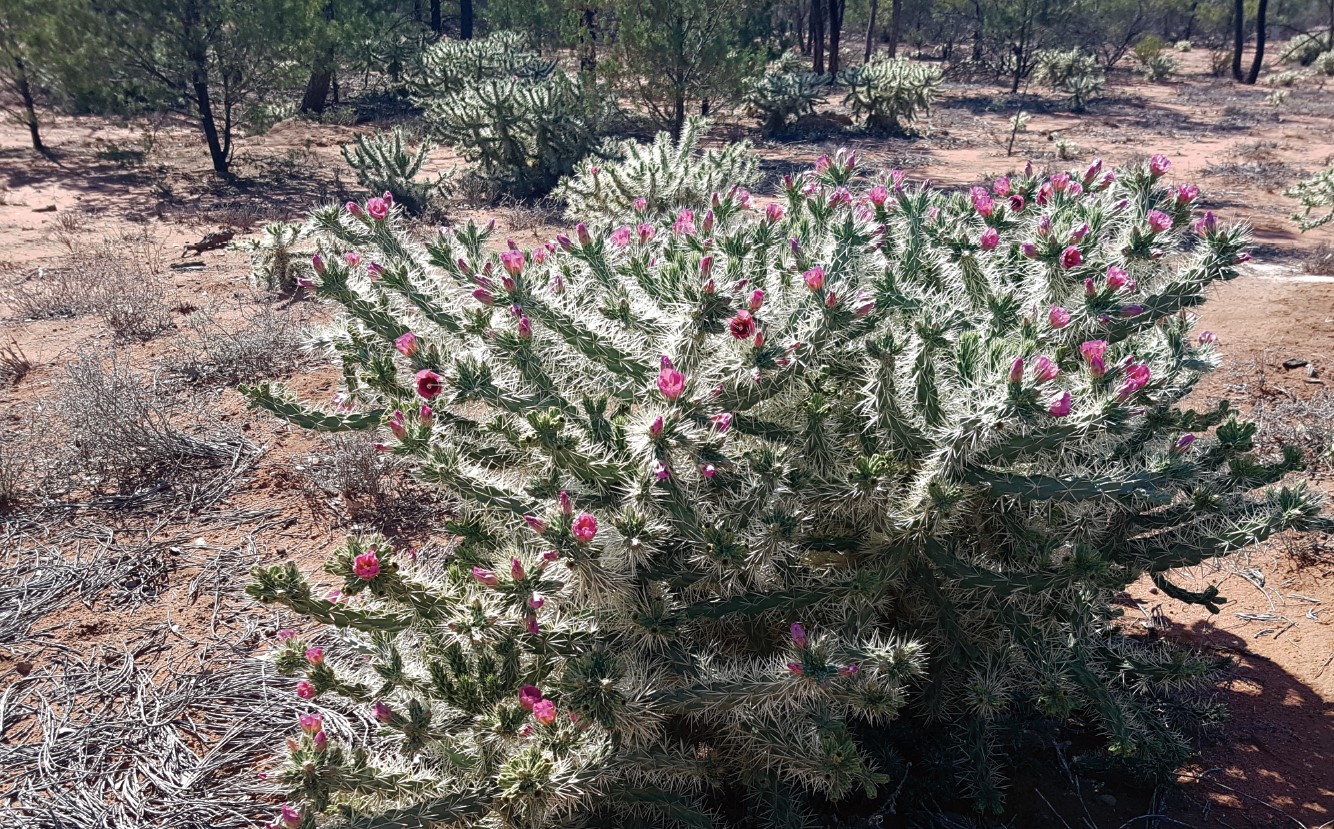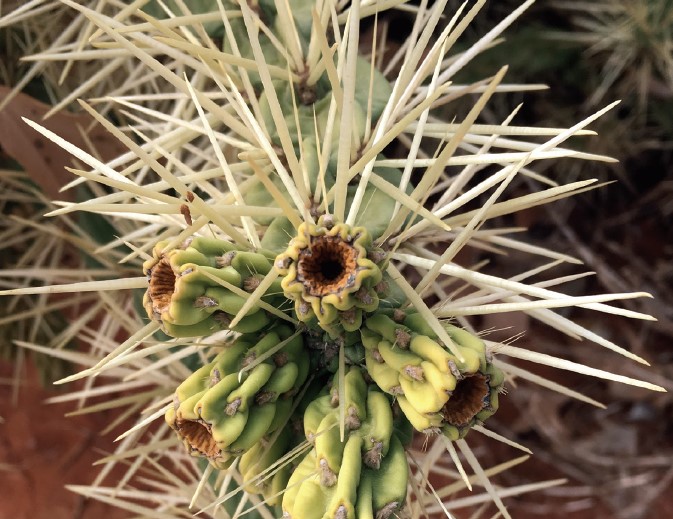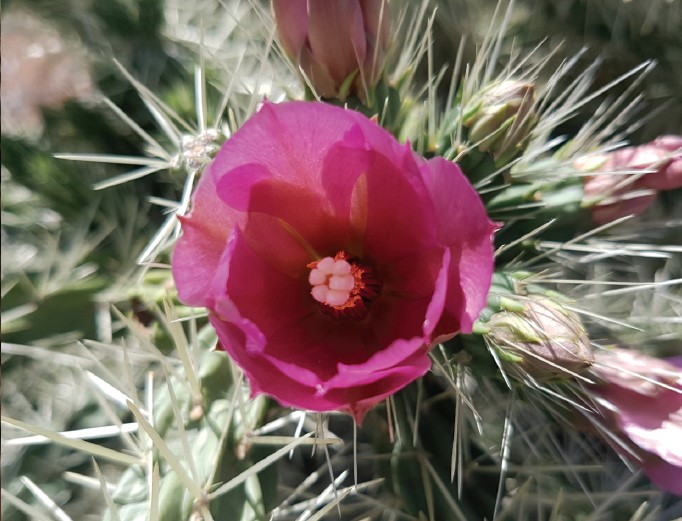Hudson pear
Hudson pear is an invasive cactus species of Mexican origin that has naturalised in a variety of habitats in north-western NSW. It has pink to purple coloured flowers, large spines and grows up to 1.5 m high and 3 m wide.
It spreads easily and rapidly and is hard to manage, seriously degrading invaded land and ecosystems.

How to identify Hudson pear?
Hudson pear is a branched cactus which grows to 1.5 m high and 3 m wide.
Spines are:
- 1 - 4 cm long
- covered with a whitish sheath which is loosely
attached - clustered in groups of 7 - 14 on small raised bumps.

Flowers are:
- pink to purple
- approximately 5 cm wide
- with a pale yellow stigma
- with golden anthers holding pollen. Anthers sit on
- top filaments that are pink at the top turning cream towards the base
- present in late spring and summer.

Images: Jo-Anna Skewes
Fruits are:
- green to yellow-green
- oblong to egg shaped
- 2 - 4.5 cm long
- less spiny as they age.
Cladodes are:
- green to grey-green
- cylinder shaped
- branched off the trunk
- 4.5 - 26 cm long and 1.5 - 3.5 cm in diameter
- easily detached.
Why is Hudson pear a problem?
Hudson pear has serious consequences and the potential to:
- injure people, stock and pets
- reduce land value
- displace native flora
- kill native fauna including koalas
- make mustering difficult
- penetrate skin, shoes and tyres with its vicious spines.
The spines have a sheath which can stay in a wound after the spine is taken out. This can cause more pain and inflammation.
North West NSW Hudson pear control program
We’re proud to be working with the community and Castlereagh Macquarie County Council to help manage Hudson pear in North West NSW.
This coordinated effort works to contain Hudson Pear with chemical spraying and biocontrol methods.
This expanded program will see us working together to recruit specialist staff for Hudson pear control, implement a program of targeted chemical and biocontrol control, and equip landholders to manage this problem species on their land.
Find out more about the Hudson pear control program and submit an expression of interest.
How does Hudson pear spread?
Hudson pear reproduces vegetatively and it is unclear whether it produces viable seed. Like many other cactus species, Hudson pear spreads by movement of segments (parts of the plant and fruit) which root when they come in contact with the ground.
Much of the spread of Hudson pear appears to be associated with livestock, native and feral animals, vehicles, and water movement. New plants are capable of growing from segments of all sizes.
How to stop Hudson pear and other cacti from spreading?
Uncontrolled, invasive cactus species spread easily and rapidly through the landscape. They are hard to manage, seriously degrading invaded land and ecosystems.
Cacti are known to hitch rides and then come loose many kilometres from where they first attached. Cacti are adaptable and will grow anywhere. They will root in the unlikeliest of places and do not need many resources to survive.
Stay on established roads and tracks
Weed control authorities manage invasive cacti along established roads and tracks, keeping them relatively cactus-free. The spines of cacti may cause flat tyres and damage to camping equipment. By staying on designated routes, needless costs can be prevented.
Stay at designated or cleared camp sites
It is easier to check for invasive cactus plants at designated or cleared camp sites. Avoid camping on or near any cacti that may cause injury to people
and pets, or result in damage to tyres, equipment or campers.
Check for attached cactus segments on your vehicle’s tyres, underside, equipment and campers
Before you leave a campsite or a known infested area, check your vehicle’s undercarriage, including the inside and outside of your tyres, for attached cactus segments.
Remove cactus segments from your tyres, vehicle undercarriage, equipment and campers.
If you find an attached cactus segment on your vehicle or equipment, ensure you remove with care using a pair of pliers or multi tool.
Check and clean your boots
Cactus spines can penetrate even the toughest of boots. It is hard to identify small cactus plants growing among scrub and other plants. Check your boots and remove cactus segments and spines using pliers or a multi-tool.
Dispose of removed cactus segments safely
Place removed segments in a red-lidded bin if one is available. Otherwise, place it in the middle of another cactus of the same species or seal it in a suitable container until you can dispose of it in a red-lidded bin.
Keep your backyard clean
Although succulents are known for being drought tolerant, all cacti are not native to Australia and can be highly invasive if not managed appropriately.
If during your travels you see a unique looking cactus specimen, do not be tempted to collect it.
Even something like the flowers or fruit could lead to its spread.
Take a photo instead and report its location to your local biosecurity officer or NSW Department of Primary Industries and Regional Development on 1800 680 244.
What are my responsibilities to control Hudson pear?
Biosecurity is the protection of the economy, environment and community from the negative impacts of pests and diseases, weeds and
contaminants.
We can only successfully manage biosecurity when every person plays their part. It is a shared responsibility, and we all need to do our bit to reduce biosecurity threats, as outlined in the NSW Biosecurity Strategy.
Being biosecure means that you:
- take steps to prevent pests, diseases and weeds from entering NSW and spreading to new areas
- keep an eye out for pests, weeds and signs of disease
- report anything unusual to NSW Department of Primary Industries and Regional Development on 1800 680 244
- participate where you can when biosecurity officers are responding to incursions and biosecurity emergencies.
What to do if you suspect Hudson pear on your property?
If you see this plant, let us know!
Contact your Local Council Biosecurity (weed officer) – there are a couple of ways you can do this:
- Phone - via the Local Council head office number
- Online enquiry form – only applicable to some councils
- Apps – only applicable to some councils.
Alternatively, you can contact the NSW DPIRD Biosecurity Helpline on 1800 680 244, or send an email (including photo if you have one) to weeds@dpi.nsw.gov.au
More information about Hudson pear is on NSW WeedWise.
Hudson pear resources
This information is largely based on resources developed through the releasing the hounds on Hudson pear program – a community-focussed integrated biological control management program. This work is a collaboration between NSW Department of Primary Industries and Regional Development, North West Local Land Services and Northern Slopes Landcare Association, funded through the NSW Government’s Office for Environment and Heritage.
Read the program's final report PDF, 7456.74 KB
